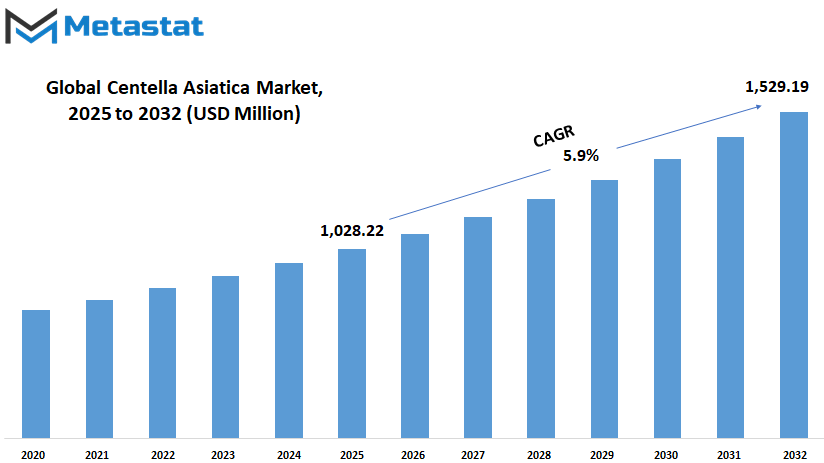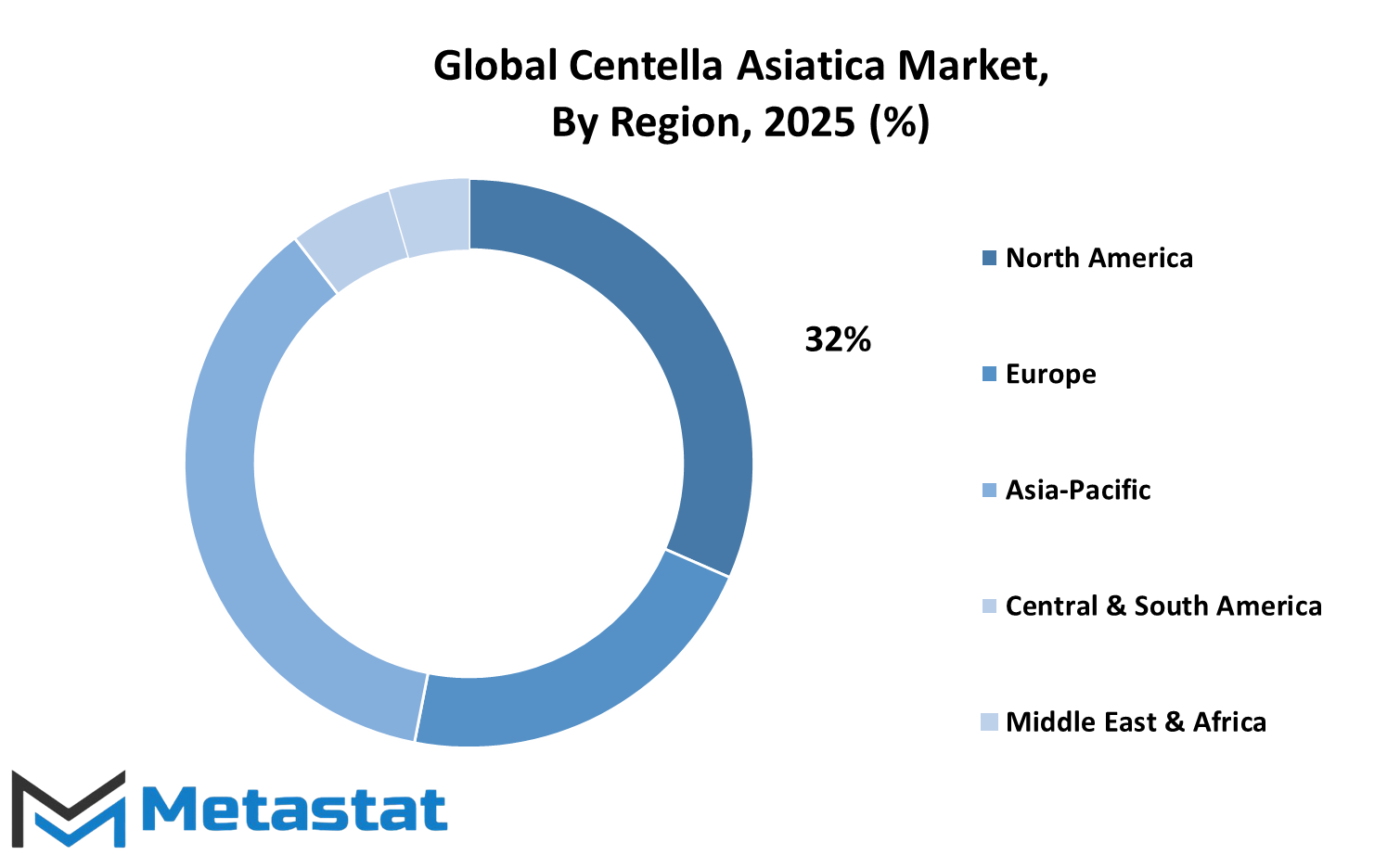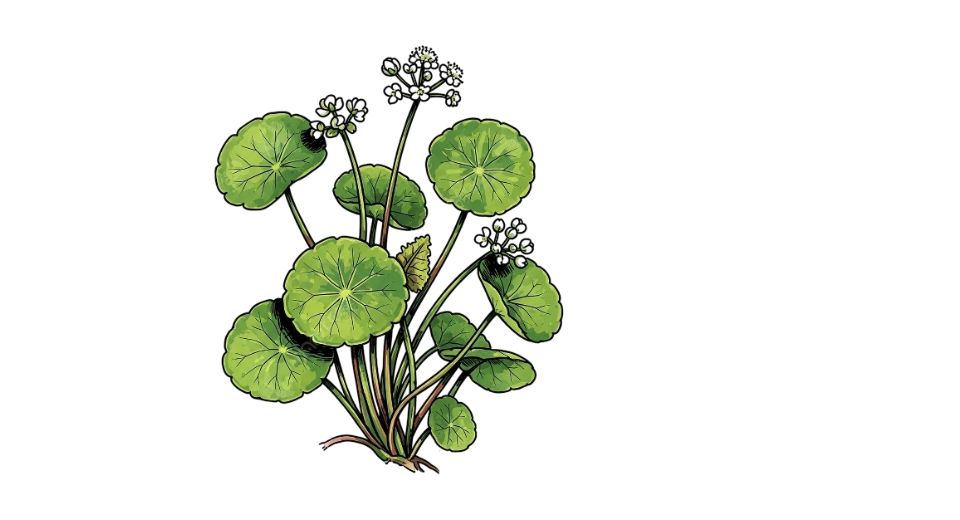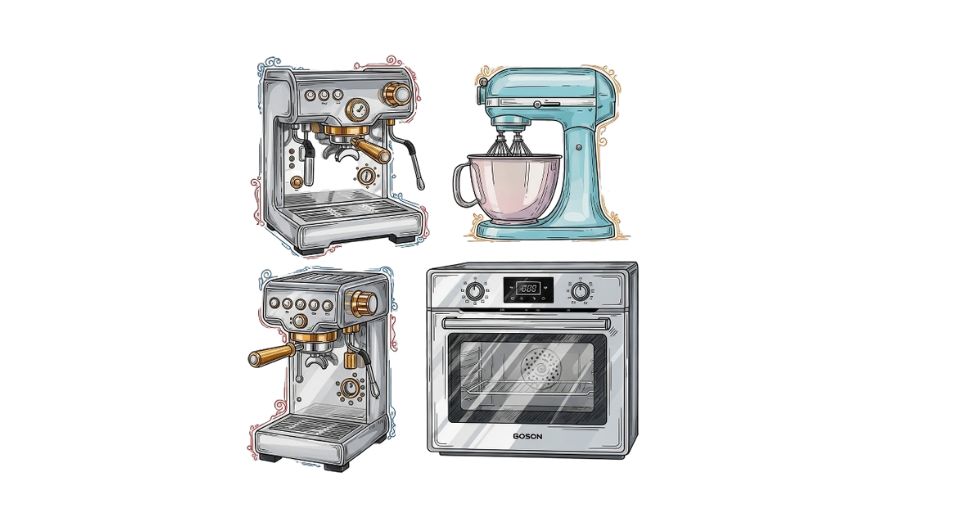MARKET OVERVIEW
The global centella asiatica market will be the cultivation, processing, and sale of a plant utilized in applications including pharmaceuticals, skincare, and dietary supplements. The market shall be founded on the demand for natural ingredients that may be incorporated in various formulations without the use of artificial additives. Centella Asiatica, a bioactive plant, will continue to be included in a wide range of consumer goods that focus on wellness, restoration, and skin health. In the global centella asiatica market, all the participants will engage in processes ranging from farm-level sourcing and raw material harvesting to formulation, packaging, and distribution.
The line will include conventionally and organically cultivated strains, with manufacturers choosing from region-based strains based on climate, potency, and phytochemical composition. Suppliers will develop vertically integrated channels for quality control from harvest through finished product. Extract types such as powders, oils, and water-dispersible forms will be engineered for industry-specific applications. Cosmetics will account for a significant share of product development within this market. With beauty brands looking for alternatives to artificial actives, Centella Asiatica will become a core ingredient in serums, creams, and facial treatments. Its perceived action towards barrier repair, moisture retention, and surface renewal will shape formulation trends for brands targeting sensitive and aging skin. Ingredient standardization and percentage levels employed across high-end and mass-product grades will be driven by research-led development.
Pharmaceutical and nutraceutical segments will also drive the trend of the global centella asiatica market. Extracts will be developed to comply with medical standards for supplements that are going to be used for cognitive support, circulatory function, and wound healing. Formulation trends will vary based on regional regulatory landscapes, requiring regional compliance strategies from manufacturers. Delivery platforms such as tablets, capsules, and functional drinks and encapsulation technology will be designed to enhance efficacy and bioavailability. Geographically, the market will be led by climatic zones favorable for the growth of centella asiatica market like the areas of Asia, Africa, and Latin America. Countries that possess well-developed agricultural infrastructure and processing units will be the major exporters.
In parallel, North American, European, and East Asian consumer markets will maintain product demand and form trends as their focus. Sustainability certifications, trade regulations, and traceability will influence global partnerships and sourcing decisions. Improved technology in plant extraction and quality control will facilitate the standardization of active ingredients, for example, asiaticoside and madecassoside. These molecules will be measured to meet levels of performance across applications. Lab confirmation, third-party confirmation, and transparent labeling will become increasingly important as consumers require assurance in purity and concentration. Formulators of products will invest in research collaborations to support claims for efficacy, leading the way to regulatory approval in more specialized health categories. The global centella asiatica market will occupy a unique space in the broader plant-based and wellness industry. As demand for traceable, efficacious natural actives continues to increase, it will establish the tone for the way consumers interact with botanical-based health and beauty. Through continued development, certification alignment, and targeted branding, it will be the benchmark for plant-derived innovation in therapeutic as well as lifestyle product forms.
Global centella asiatica market is estimated to reach $1,529.19 Million by 2032; growing at a CAGR of 5.9% from 2025 to 2032.

GROWTH FACTORS
The global centella asiatica market is increasingly becoming the subject of attention, with evidence of robust future prospects. The reason being its application in skincare, medicine, and nutritional supplements. With people increasingly relying on natural products and plant extracts, Centella Asiatica, due to its calming and healing nature, is fast emerging as a sought-after product. This does not seem to change anytime soon. Customers are opting for products that are skin-friendly and do not contain chemicals. This demand change is motivating most companies to add Centella Asiatica to their products, thereby expanding the market even more. Improved awareness of skin health ranks among the most important catalysts for the advancement of the market.
Individuals are becoming more aware of what they put on their body, and this herb has something to offer that is difficult to ignore. It is thought to assist in rebuilding the skin, diminishing redness, and soothing irritation. One other factor in favor of growth is the rise in wellness and self-care practices. The notion of making time to nurture one's mind and body is being embraced by many. These routines frequently incorporate products that have Centella Asiatica in them, so they become more appealing. There are some challenges the market could experience, though. The first one is that there is no uniform product quality.
Centella Asiatica is a plant, so its characteristics vary depending on how and where the plant grows. This creates a problem for companies because it is hard for them to have standard results across all of their products. Another obstacle could be the low awareness in certain areas. Although it is well-received in sections of Asia, most other sections of the world are not yet aware of it. With not enough knowledge or faith in its impact, individuals may not wish to purchase products that contain this component. In the future, the marketplace will most likely be opened up to new avenues. More research and development may result in new product forms and improved means of unlocking its benefits. If there is an emphasis on raising awareness and informing consumers, even more people may begin incorporating it into their daily lives.
This would boost its demand worldwide. More liaison between science and natural product developers will also see new answers that attract more users. In the next few years, the global centella asiatica market should experience a strong upward trend. As consumers become increasingly interested in clean beauty, well-being, and natural healing, the plant's application in various industries appears to grow.
MARKET SEGMENTATION
By Product Type
The global centella asiatica market is increasing gradually, driven by trends in the perception of natural products and wellness solutions. With more people grasping the advantages of ancient plants, Centella Asiatica is beginning to attract attention in different industries. The herb, which possesses soothing and healing effects, is finding its way into cosmetics, health supplements, as well as functional foods. In the years to come, its scope is likely to increase, led by increasing demand for plant-derived products that benefit physical as well as mental health. In the future, the global centella asiatica market is likely to increase through various product types.
Based on product type, this market is categorized into powder, liquid, and other types. Powdered Centella Asiatica is extensively applied in capsules, tablets, and topically used blends, where it facilitates convenient mixing and standardized use. It has emerged as a favorite among manufacturers seeking a reliable and flexible format. Liquid Centella Asiatica, meanwhile, is making inroads in skincare and beverage health products. Its fluid form makes it suitably applicable in serums, toners, and infused beverages. With consumers seeking quicker-absorbing products, the liquid category is likely to continue to draw greater attention. Formats like pastes or extracts used in bespoke formulations make up the second category. These formats are flexible for companies wishing to develop innovative products that are designed to serve particular consumer requirements. The future of the global centella asiatica market hinges on the way industries respond to trends relating to natural health and sustainable living. With the move towards clean and simple ingredient panels gaining momentum, Centella Asiatica will increasingly find itself in the formulations of many new products.
More research will be involved, too. As more and more studies bring its advantages to the fore, from enhancing the appearance of the skin to lowering stress and raising cognitive ability, demand is sure to rise. This will create opportunities for innovation, particularly in wellness-oriented sectors that will promote both internal and external health. The global centella asiatica market is not merely a reflection of the momentary focus on natural products. It's about the expanding conviction that nature holds secrets to tackling contemporary problems. This wave is likely to go deeper, creating space for Centella Asiatica in everyday usage. Its prospects are bright, guided by curiosity, science, and the constant quest for products that make one feel and look better minus the harsh stuff.
By Application
The global centella asiatica market is predicted to expand steadily in the future with increasing demand for natural ingredients and plant-based solutions for health and wellness. Since herbal and traditional medication is becoming increasingly popular, Centella Asiatica has been recognized for its possibilities in a variety of health spaces. While traditionally used in medicine, Centella Asiatica is increasingly being researched and developed in modern-day products.
Several consumers are searching for products that can promote cleanliness and skin well-being without resorting to harsh chemicals, and extracts from this plant are promising in that regard. Another field in which this plant extract is making its presence felt is in soothing irritation and subsiding swelling. This is attracting interest from pharmaceutical and skincare companies equally, particularly as individuals seek to find calming products for sensitive skin or to treat conditions associated with inflammation. Centella Asiatica's anti-cancer properties are also an expanding field of research. While further studies will continue to be required to prove its efficacy, preliminary results are promising.
These results are providing an avenue for the discovery of alternative treatments that could complement standard therapies. So too is there curiosity about how the extract can guard brain function. Scientists are starting to investigate how it can maintain memory and help prevent damage associated with stress and aging. In antioxidants is another potential application. As people become increasingly concerned about pollution, processed foods, and damage related to lifestyle, consumers are actively looking for methods of cell protection and maximizing health from the inside out. Centella Asiatica is being investigated for its ability to assist there, orally and when applied topically.
Last but not least, the plant's help for healing wounds is one of the more proven uses. It is being added to creams and ointments to accelerate recovery and minimize scarring. With increasing demand in these diverse uses, the global centella asiatica market stands poised to become integral to future natural health and skincare formulations. As additional scientific backing accumulates behind its impacts, firms will increasingly invest in this plant and its applications.
By End Use
The global centella asiatica market is evidencing steady growth due to its growing presence in both cosmetic and non-cosmetic sectors. This herb, traditional medicine's old-time favorite, is increasingly being sought out for its natural attributes that aid in healing and repair of the skin. As individuals become more inclined towards health-oriented and herbal solutions, industries are starting to explore more seriously how Centella Asiatica can be integrated into daily products.
In beauty, Centella Asiatica has already left its presence. It appears in creams, serums, and lotions that target calming the skin or elasticity improvement. Consumers who are being careful with chemical-based products are seeking products that incorporate natural ingredients such as Centella Asiatica. Companies that carry it are viewed as more responsible and health-oriented, which is driving them to establish closer relationships with buyers. The increased demand for clean skincare is also likely to continue propelling this market. Its non-cosmetic applications are also becoming increasingly significant.
Centella Asiatica is being incorporated in food supplements, beverages, and wellness products. It is also thought to enhance memory, stress down, and even facilitate the healing of wounds. With further research being carried out, its advantages could be even more widely used, giving rise to it in newer segments. Hospitals, health centers, and even gym brands can venture into how this herb can be integrated into their product or services. Individuals are looking for more natural means of being healthy, and Centella Asiatica could fill that need.
In the future, the global centella asiatica market may experience more innovation. Businesses might create methods of isolating the plant's characteristics more effectively or combining it with other herbal ingredients for greater impacts. Agricultural practices could advance as well, emphasizing organic development to serve clean label requirements. Should additional nations legalize the plant use for medicinal or therapeutic uses, it may create entirely new directions for business expansion. As knowledge expands, both the non-cosmetic and cosmetic aspects of the market will grow. From health stores to skincare shelves, the plant's reach will extend into even more places where natural health solutions are required.
With shifting consumer behavior and escalating research, the global centella asiatica market will keep discovering new value and direction. Its destiny is not only in the future of the farmers who cultivate and sell it, but also in the hands of numerous individuals who can benefit from its utilization.
|
Forecast Period |
2025-2032 |
|
Market Size in 2025 |
$1,028.22 million |
|
Market Size by 2032 |
$1,529.19 Million |
|
Growth Rate from 2025 to 2032 |
5.9% |
|
Base Year |
2024 |
|
Regions Covered |
North America, Europe, Asia-Pacific Green, South America, Middle East & Africa |
REGIONAL ANALYSIS
The global centella asiatica market will be able to see significant transformations in the near future as regional demand trends change, and fresh consumer trends are developed. Centella Asiatica, a natural plant used in skincare and health supplements, is increasingly attracting attention in various regions. Each region has its own rate of expansion, based on cultural acceptance, awareness about natural products, and economic stability. North America, encompassing the U.S., Canada, and Mexico, has been expressing a high demand for herbal ingredients on account of increasing health awareness. Here, the plant is utilized in wellness and cosmetic formulations. Demand is likely to rise even more as consumers trend towards clean and natural ingredients. In Europe, nations like the UK, Germany, France, and Italy are experiencing a slow but steady increase in the application of Centella Asiatica.
The emphasis on plant-based and sustainable products in Europe fuels this trend. Consumers in Europe are increasingly conscious of the composition of products they apply to the skin as well as use in health supplements. With regulations turning more natural-friendly, the market will most likely see an upward trend. Meanwhile, the Asia-Pacific region, including India, China, Japan, and South Korea, remains one of the strongest areas for Centella Asiatica. This is not only because the plant has a traditional presence in many Asian cultures but also because of strong production and processing capabilities in these countries. Demand will probably continue to be strong and possibly increase as current research justifies the uses known to most cultures for centuries. South America, especially Brazil and Argentina, is starting to tap into the possibilities of Centella Asiatica. The plant is increasingly being valued for its potential application in both cosmetics and well-being.
Information campaigns and enhanced access to international trends will go a long way in determining this region's future demand. The Middle East and African regions, spanning the GCC nations, Egypt, and South Africa, are also showing initial signs of expansion. With the evolving way of life and increased interest in health-oriented products, the potential here will materialize in the fullness of time. These areas can start to experience increased market activity as distribution channels become more efficient. Generally, local tastes and access to a trusted source influence each region's growth, and the future years can introduce new dynamics that realign the global centella asiatica market.

COMPETITIVE PLAYERS
The global centella asiatica market is slowly but surely gaining traction, as worldwide demand for plant-based goods just keeps increasing. Centella Asiatica, traditionally utilized for its medicinal properties, is now being researched for both conventional and contemporary uses. It is appreciated for its application in skincare, medicine, and wellness products, and it isn't showing any signs of losing popularity. Individuals are starting to opt for natural ingredients as compared to chemical ones, and this shift in demand will end up transforming the future of this industry. As demand increases, competitive players are emerging to hold their stakes.
Firms such as Lotioncrafter LLC. and Alchem International Pvt. Ltd. are investing in research and scaling up their production capacity. Others, like Earth Rhythm and Botanic Healthcare, are succeeding on the back of selling more sustainable and environmentally friendly products. These companies are trying to fulfill increasing consumer demands without compromising on quality. HERBAL CREATIONS and Himalaya Wellness are leveraging their current reputations to maintain their positions and trying out new products to address altering customer needs. Larger enterprises such as L'Oreal are also entering, with the clout of established brand names and international reach. Their entrance indicates that this sector is not a fad but a trend that is set to grow in strength.
Phyto Life Science and BGP Healthcare Private Limited are looking to establish alliances and enhance their supply chains, which could enable them to remain in the game as the market grows. Lepro Herbals Pvt. Ltd. is focusing on keeping production methods rooted in traditional knowledge while also keeping pace with modern expectations. In the future, the industry will become increasingly diversified, with firms not only focusing on skincare but also looking at Centella Asiatica's potential within health supplements and wellness solutions. With the help of science continuing to prove its efficacy, more individuals might use this plant as a permanent fixture in their health and beauty regimens.
The firms that are able to integrate traditional intelligence with innovation will be the most prominent. What is certain is that the global centella asiatica market is drawing in players who are serious about growth. With careful strategies and knowledge of consumers' needs, these companies will define what this market will look like in the years to come. Those who are able to remain agile and innovative will most likely take the lead as interest in Centella Asiatica continues to grow.
Centella Asiatica Market Key Segments:
By Product Type
- Powder
- Liquid
- Other
By Application
- Anti-microbial
- Anti-inflammatory
- Anti-cancer
- Neuro-protective
- Antioxidant, and Wound Healing
- Other
By End Use
- Cosmetic
- Non-cosmetic Uses
Key Global Centella Asiatica Industry Players
- Lotioncrafter LLC.
- Alchem International Pvt. Ltd.
- Earth Rhythm
- Botanic Healthcare
- HERBAL CREATIONS
- Himalaya Wellness
- L’Oreal
- Phyto Life Science
- BGP Healthcare Private Limited
- Lepro Herbals Pvt. Ltd.
WHAT REPORT PROVIDES
- Full in-depth analysis of the parent Industry
- Important changes in market and its dynamics
- Segmentation details of the market
- Former, on-going, and projected market analysis in terms of volume and value
- Assessment of niche industry developments
- Market share analysis
- Key strategies of major players
- Emerging segments and regional growth potential








 US: +1 3023308252
US: +1 3023308252






